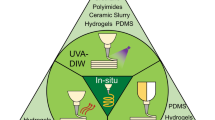Abstract
3D printing, also called additive manufacturing, is being used increasingly in tissue engineering. However, the printing accuracy remains limited, making it difficult to prepare a tissue engineering scaffold with high precision and high porosity. Melt electrowriting (MEW) technology is based on extrusion printing, in which an extruded material is pulled by the action of an electric field, thereby reducing the fiber diameter and improving the printing accuracy. However, MEW technology imposes high requirements on the material properties, and therefore, few printing materials are currently available for use in this process. The present study investigates the characteristics and molding conditions of polycaprolactone, a commonly used printing material, as well as other materials such as poly(lactic-co-glycolic acid), poly(ethylene glycol) diacrylate/polyethylene oxide, gelatin methacrylate, and hyaluronic acid methacrylate for MEW applications, and develops new and suitable inks for MEW that will provide more and better choices for constructing a bioactive scaffold in future tissue engineering research. Experiments suggest that a printing ink should have low electrical conductivity, suitable viscosity, and high curing speed for realizing successful printing.
Similar content being viewed by others
References
CHEN L, DENG C J, LI J Y, et al. 3D printing of a lithium-calcium-silicate crystal bioscaffold with dual bioactivities for osteochondral interface reconstruction [J]. Biomaterials, 2019, 196: 138–150.
GAO Q, NIU X F, SHAO L, et al. 3D printing of complex GelMA-based scaffolds with nanoclay [J]. Biofabrication, 2019, 11(3): 035006.
HEWITT E, MROS S, MCCONNELL M, et al. Meltelectrowriting with novel milk protein/PCL biomaterials for skin regeneration [J]. Biomedical Materials (Bristol, England), 2019, 14(5): 055013.
HOCHLEITNER G, FÜRSATTEL E, GIESA R, et al. Melt electrowriting of thermoplastic elastomers [J]. Macromolecular Rapid Communications, 2018, 39(10): 1800055.
JØRGENSEN M L, MÜLLER C, SIKKERSOQ M, et al. A melt-electrowritten filter for capture and culture of circulating colon cancer cells [J]. Materials Today Bio, 2020, 6: 100052.
HRYNEVICH A, ELÇI B Ş, HAIGH J N, et al. Dimension-based design of melt electrowritten scaffolds [J]. Small, 2018, 14(22): 1800232.
CHEN H, MALHEIRO A B F B, VAN BLITTERSWIJK C, et al. Direct writing electrospinning of scaffolds with multidimensional fiber architecture for hierarchical tissue engineering [J]. ACS Applied Materials & Interfaces, 2017, 9(44): 38187–38200.
TOWNSEND J M, OTT L M, SALASH J R, et al. Reinforced electrospun polycaprolactone nanofibers for tracheal repair in an in vivo ovine model [J]. Tissue Engineering Part A, 2018, 24(17/18): 1301–1308.
DALTON P D, WOODFIELD T B F, MIRONOV V, et al. Advances in hybrid fabrication toward hierarchical tissue constructs [J]. Advanced Science, 2020, 7(11): 1902953.
PAXTON N C, LANARO M, BO A, et al. Design tools for patient specific and highly controlled melt electrowritten scaffolds [J]. Journal of the Mechanical Behavior of Biomedical Materials, 2020, 105: 103695.
LEE J W, PARK J Y, PARK S H, et al. Cross-linked electrospun cartilage acellular matrix/poly(caprolactone-co-lactide-co-glycolide) nanofiber as an antiadhesive barrier [J]. Acta Biomaterialia, 2018, 74: 192–206.
BAS O, DE-JUAN-PARDO E M, MEINERT C, et al. Biofabricated soft network composites for cartilage tissue engineering [J]. Biofabrication, 2017, 9(2): 025014.
WUNNER F M, WILLE M L, NOONAN T G, et al. Melt electrospinning writing of highly ordered large volume scaffold architectures [J]. Advanced Materials, 2018, 30(20): 1706570.
QI H F, YE Z H, REN H L, et al. Bioactivity assessment of PLLA/PCL/HAP electrospun nanofibrous scaffolds for bone tissue engineering [J]. Life Sciences, 2016, 148: 139–144.
ZEUGOLIS D I, KHEW S T, YEW E S Y, et al. Electro-spinning of pure collagen nano-fibres: Just an expensive way to make gelatin? [J]. Biomaterials, 2008, 29(15): 2293–2305.
WEI C, DONG J Y. Hybrid hierarchical fabrication of three-dimensional scaffolds [J]. Journal of Manufacturing Processes, 2014, 16(2): 257–263.
PUCKERT C, TOMASKOVIC-CROOK E, GAMBHIR S, et al. Electro-mechano responsive properties of gelatin methacrylate (GelMA) hydrogel on conducting polymer electrodes quantified using atomic force microscopy [J]. Soft Matter, 2017, 13(27): 4761–4772.
Author information
Authors and Affiliations
Corresponding authors
Additional information
Foundation item: the National Key R&D Program of China (Nos. 2018YFB1105600 and 2018YFA0703000), the National Natural Science Foundation of China (No. 81802131), and the China Postdoctoral Science Foundation (No. 2019T120347)
Rights and permissions
About this article
Cite this article
Han, Y., Sun, B., Jiang, W. et al. Formability of Printing Ink for Melt Electrowriting. J. Shanghai Jiaotong Univ. (Sci.) 26, 411–415 (2021). https://doi.org/10.1007/s12204-021-2313-5
Received:
Accepted:
Published:
Issue Date:
DOI: https://doi.org/10.1007/s12204-021-2313-5




